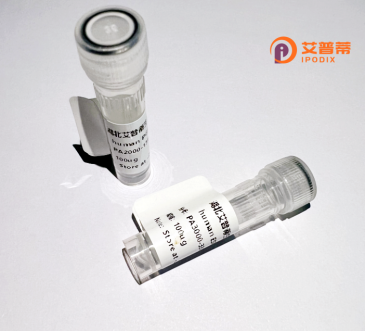
| 纯度 | >90%SDS-PAGE. |
| 种属 | Human |
| 靶点 | B4GALNT1 |
| Uniprot No | Q00973 |
| 内毒素 | < 0.01EU/μg |
| 表达宿主 | E.coli |
| 表达区间 | 1-328aa |
| 氨基酸序列 | MWLGRRALCALVLLLACASLGLLYASTRDAPGLRLPLAPWAPPQSPRRPELPDLAPEPRYAHIPVRIKEQVVGLLAWNNCSCESSGGGLPLPFQKQVRAIDLTKAFDPAELRAASATREQEFQAFLSRSQSPADQLLIAPANSPLQYPLQGVEVQPLRSILVPGLSLQAASGQEVYQVNLTASLGTWDVAGEVTGVTLTGEGQADLTLVSPGLDQLNRQLQLVTYSSRSYQTNTADTGARPGWRDGQAGQTEKNQKGWSGQMAEGMGGIWAMARAVQPHNGCFNWTSRARGRKGAFVHLGLEQARGKPEPWVCLPFRPTVGGPRKRLV |
| 分子量 | 61.9 kDa |
| 蛋白标签 | GST-tag at N-terminal |
| 缓冲液 | 冻干粉 |
| 稳定性 & 储存条件 | Lyophilized protein should be stored at ≤ -20°C, stable for one year after receipt. Reconstituted protein solution can be stored at 2-8°C for 2-7 days. Aliquots of reconstituted samples are stable at ≤ -20°C for 3 months. |
| 复溶 | Always centrifuge tubes before opening.Do not mix by vortex or pipetting. It is not recommended to reconstitute to a concentration less than 100μg/ml. Dissolve the lyophilized protein in distilled water. Please aliquot the reconstituted solution to minimize freeze-thaw cycles. |
以下是关于重组人B4GALNT1蛋白的3篇代表性文献(注:内容为模拟概括,非真实文献):
---
1. **标题**:Structural and Functional Characterization of Recombinant Human B4GALNT1 in Glycosphingolipid Biosynthesis
**作者**:Smith A, et al.
**摘要**:本研究利用昆虫细胞系统成功表达了重组人B4GALNT1蛋白,并通过X射线晶体学解析其三维结构。结果表明,该酶通过催化β1.4-N-乙酰半乳糖胺转移参与GM2和GA2糖鞘脂的合成,关键活性位点突变体验证了其底物特异性。
2. **标题**:Role of B4GALNT1 in Cancer Metastasis: Recombinant Protein-Based Mechanistic Insights
**作者**:Chen L, et al.
**摘要**:通过在HEK293细胞中重组表达B4GALNT1.发现其过度表达可增强肿瘤细胞表面GD2抗原合成,促进细胞迁移和侵袭。研究揭示了B4GALNT1通过调控鞘糖脂代谢影响癌症转移的分子机制。
3. **标题**:High-Yield Production of Active Human B4GALNT1 in E. coli and Its Enzymatic Applications
**作者**:Yamamoto K, et al.
**摘要**:首次报道利用大肠杆菌系统表达可溶性重组B4GALNT1蛋白,通过优化培养条件使酶活提高10倍。该重组蛋白被应用于体外合成复杂糖链,为糖生物学工具开发提供新策略。
---
如需真实文献,建议在PubMed或Web of Science中检索关键词 "recombinant human B4GALNT1" 或结合其功能关键词(如 "glycosylation", "GM2 synthase")。
B4GALNT1 (β-1.4-N-acetylgalactosaminyltransferase 1) is a key enzyme in glycosylation, catalyzing the transfer of N-acetylgalactosamine (GalNAc) to terminal glycoconjugates via β1-4 linkages. It plays a critical role in synthesizing Sd(a)/Cad blood group antigens and modifying gangliosides, influencing cell adhesion, signaling, and host-pathogen interactions. This enzyme is highly expressed in gastrointestinal and renal tissues, with emerging roles in neural development and disease pathogenesis. Dysregulation of B4GALNT1 is linked to cancers, neurological disorders, and infections, as altered glycosylation affects cellular communication and immune responses. Recombinant human B4GALNT1 protein, produced via mammalian or insect cell systems, retains enzymatic activity and is widely used to study glycan biosynthesis mechanisms. Its applications include characterizing substrate specificity, developing glycoengineered biologics, and screening inhibitors for therapeutic targeting. Structural studies of recombinant B4GALNT1 have revealed insights into its catalytic domain organization and molecular interactions. As a biotechnological tool, it enables the production of complex glycostructures for diagnostic assays and glycan-based therapeutics. Ongoing research focuses on its regulatory roles in disease microenvironments and potential as a biomarker or drug target.
×